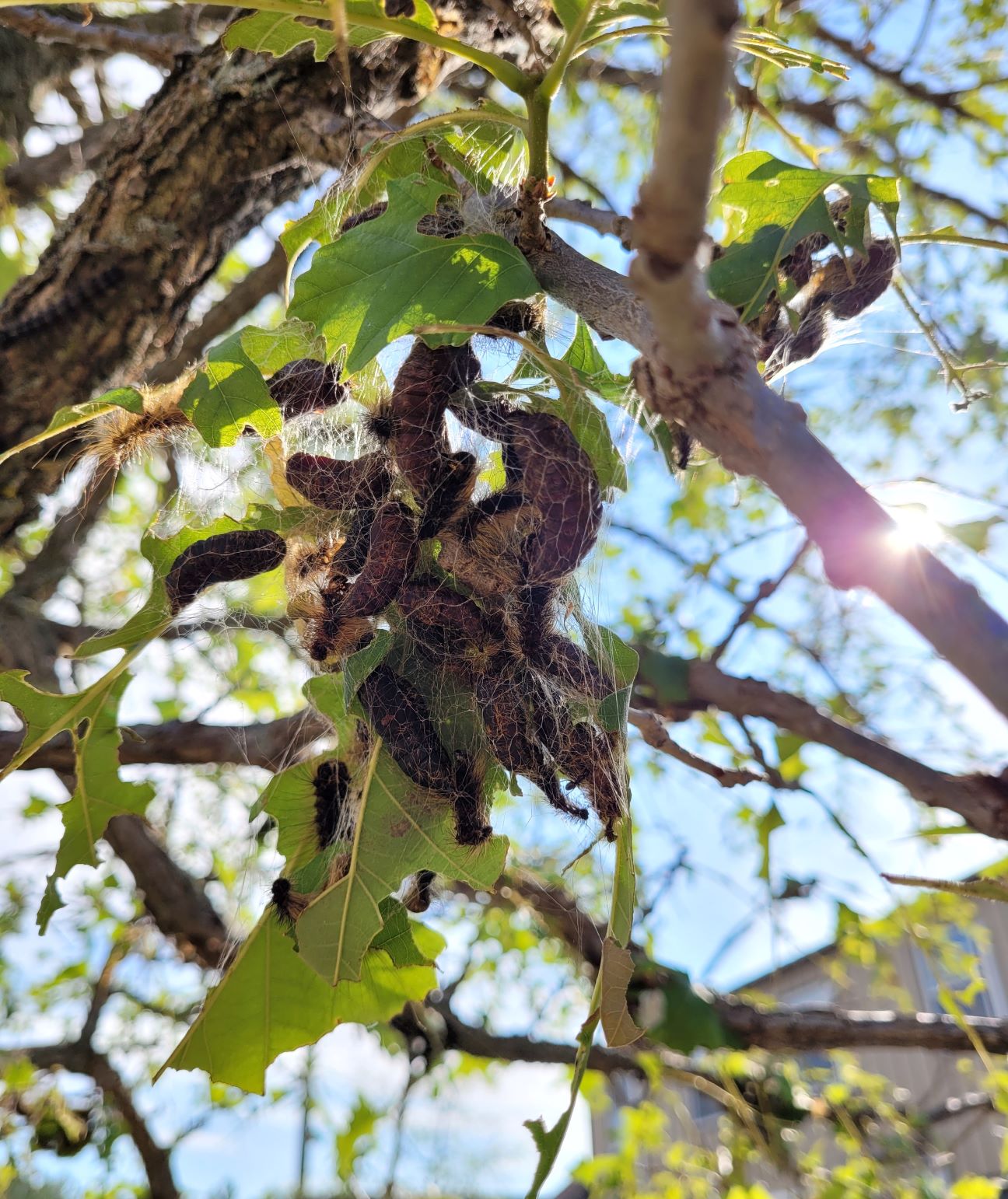

Above left: A gypsy moth outbreak that is affecting forestry across post and New York state has the attention of the Natural Resources Branch at Fort Drum. (Photo by Mike Strasser, Fort Drum Garrison Public Affairs)
Above right: The gypsy moth caterpillar feeds mostly on oak trees, but it is known to invade a variety of trees – causing leaf damage and tree defoliation. (Photo by Amy Stiefel, Fort Drum Natural Resources Branch)
Fort Drum Natural Resources Branch team tracks gypsy moth outbreak on installation
Mike Strasser
Fort Drum Garrison Public Affairs
FORT DRUM, N.Y. (June 30, 2021) – If it flies, runs, crawls or swims anywhere on Fort Drum, most likely a team from the Natural Resources Branch is tracking it. And what has their attention at the moment is the gypsy moth outbreak that is affecting forestry across New York state.
Rodger Voss, Fort Drum forester, said that the gypsy moth caterpillar feeds mostly on oak trees, but it is known to invade a variety of trees – causing leaf damage and tree defoliation.
“Our whole Natural Resources team is always looking out for things like this,” Voss said. “Our bird biologist (Jeff Bolsinger) keyed us in on this because last season he noticed an increase in cuckoo populations, which he attributed to the beginning of this infestation. It wasn’t really visible yet, defoliation-wise, but the caterpillars were there. He said every time the population of these caterpillars ramp up, so does the cuckoo population.”
Voss estimates that roughly 1,000 acres has been affected on post so far, with the infestation focused primarily in and around the cantonment area. It is also starting to creep into the training areas. As the caterpillars strip away all the leaves from the trees, the loss of canopy shade and the increase in dry leaf debris could lead to an increased fire danger.
“For the most part, it’s not really a major concern yet,” he said. “Most of the hardwoods will re-leaf in mid-July, as long as we keep getting some precipitation, and you’ll see all these tiny leaves on the trees.”
Across from the Natural Resources building, a swath of pine trees – void of all its needles – will not be so fortunate. Voss noted that caterpillars even stripped an entire spruce tree in the housing loop near the LeRay District.
Amy Stiefel, Fort Drum forester, said that although caterpillars prefer oak trees they will eventually latch onto any available tree for sustenance.
“More or less, any tree that was in their path they ate through,” she said. “When I was out here earlier taking photos, you walked through and it sounded like it was raining from all the leaf litter falling and the caterpillars were everywhere.”
Voss said that this is probably the last week of active feeding, as the caterpillars pupate and form cocoons on the trees. He said that the best course of action is to let nature run its course.
“What really ends up stopping the gypsy moth infestation is a combination of predators, like birds, but mostly it is a virus and a fungus that persist in the environment,” he said. “The virus gets into their intestinal system and kills them. They dry out and hang in a ‘J’ shape off the tree. That’s when you know the virus is starting to take effect.”
Voss said it is a very specific virus that kills only the gypsy moth, and it is already doing its work on the current population.
“But it takes two or three years to knock the caterpillar population back down, so I consider this year one of our outbreak. Most likely it is going to get worse, but we hope to be wrong about that.”
Voss said a gypsy moth outbreak usually occurs every 10 to 15 years, but it has been closer to 20 since the last one at Fort Drum.
“I remember it was when I first started working here, around 2000 or 2001, and we had it bad around the airfield,” he said. “It looked just like this – completely defoliated. So we’re lucky we made it this long between outbreaks.”
To learn more about the gypsy moth, visit www.dec.ny.gov/animals/83118.html. To see photos of the infestation on post, visit Fort Drum Natural Resources at www.facebook.com/FortDrumNaturalResources.





